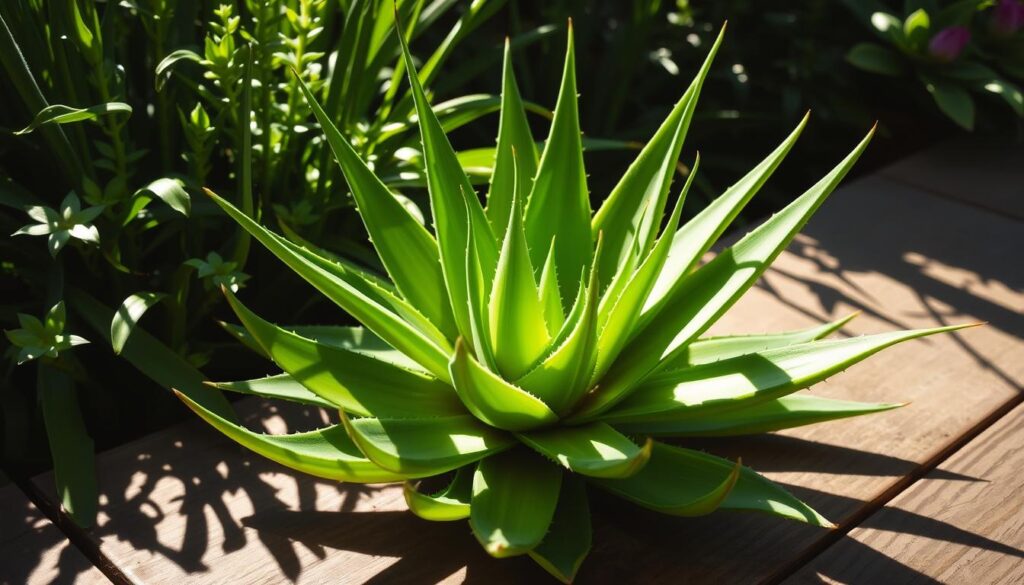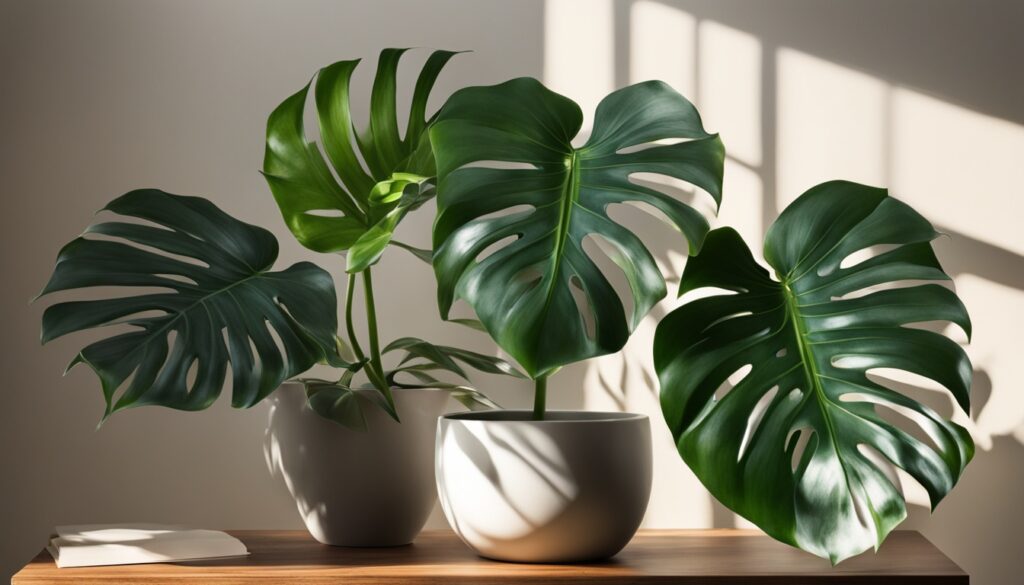Aloe vera plants are known for their healing powers. They need at least six hours of direct sunlight each day to grow well. This might surprise you, as these plants are often thought to do best in low light. But knowing their desert home helps us give them the right amount of sunlight.
These plants come from dry, desert areas. They grow in the shade of bigger plants. In their natural setting, they get plenty of indirect sunlight. This means they get sunlight for more than 6 hours a day, but not straight on.
Key Takeaways
- Aloe vera plants need at least 6 hours of direct sunlight a day to stay healthy and not stretch too much.
- They also do well in indirect sunlight, like bright, filtered light, as long as it’s for at least 6 hours.
- These plants love dry soil and warm temperatures between 60-75°F.
- Getting the right amount of sunlight is key for their growth. Too little light can cause problems like etiolation and color changes.
- It’s important to adjust the light your aloe vera plant gets with the seasons to keep it healthy and growing well.
Understanding Aloe Vera’s Natural Habitat
Aloe vera is a succulent plant from sub-Saharan Africa, the Arabian Peninsula, and Indian Ocean islands. It thrives in dry, desert-like environments. Its fleshy leaves store water, protected by a thick skin and waxy layer. This helps it survive in less moist places, growing up to 24 inches tall.
Native Desert Environment
Aloe vera loves a desert climate with hot, arid conditions and little rain. Its large leaves help it lose less water, saving moisture in harsh, dry conditions.
Natural Growth Patterns
In the wild, aloe vera grows in a compact, rosette shape. Its thick leaves spiral around the stem. This pattern helps it store water and get sunlight, key for desert survival.
Adaptation to Harsh Conditions
Aloe vera’s ability to live in dry, sunny places shows its amazing adaptations. Its thick leaves and water storage help it handle drought and intense sunlight. This makes it perfect for desert life.
“Aloe vera thrives in bright, indirect sunlight, simulating its natural habitat in sun-drenched deserts.”
How Much Sunlight Does An Aloe Vera Plant Need
Aloe vera plants need at least six hours of sunlight daily to grow well. They like full, indirect sunlight. Direct sunlight can cause leaf burn and dry out the plant.
They are used to filtered sunlight, which helps them grow without stretching or burning. This balance is key for their health and beauty.
- Aloe vera plants thrive in temperatures between 55 and 80°F (13 and 27°C), typical for indoor spaces.
- Three to four hours of direct, warm sun daily can help them grow well.
- Too much direct sunlight can burn their leaves, especially if they’re moved from shade to sun.
Knowing how much sunlight aloe vera needs is crucial for their health. Adjust their light exposure based on the season and their spot in your home or garden.
| Sunlight Requirement | Ideal Conditions | Potential Issues |
|---|---|---|
| Minimum 6 hours per day | Full, indirect sunlight | Leaf sunburn and drying from direct sun exposure |
| Bright, direct sunlight | 3-4 hours per day | Burning and damage from overexposure |
| Sparse, indirect sun | Can tolerate, but growth will slow | Insufficient light leading to stretching and etiolation |
By giving your aloe vera the right amount of sunlight, it will grow strong and look great. Finding the right mix of direct and indirect light is essential for a healthy aloe vera plant.
“Aloe vera plants are not picky when it comes to soil, as long as it is well-draining and slightly sandy.”
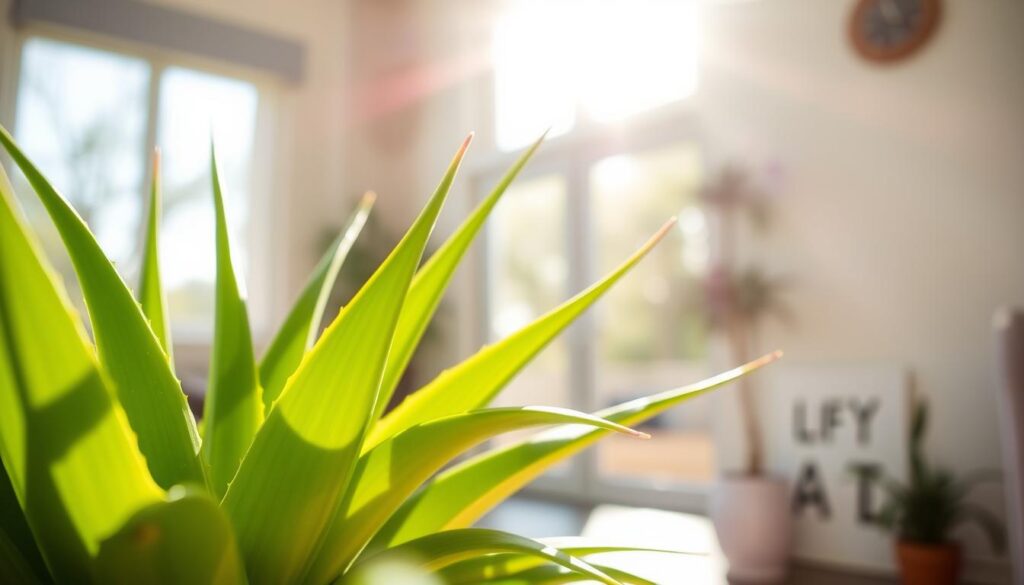
Direct vs Indirect Sunlight Requirements
For aloe vera plants, the right sunlight is key. Direct sunlight hits the plant straight, while indirect light is filtered first.
Understanding Direct Sunlight Impact
Some plants love direct sunlight all day. But aloe vera is not one of them. Too much direct sunlight can burn the leaves, causing brown spots or a red-gray color. It can also dry out the leaves too quickly.
Benefits of Indirect Light
Aloe vera plants prefer indirect light. This kind of light is like the desert shade they love. It gives them the right amount of light without being too harsh.
Seasonal Light Changes
Move your aloe vera with the seasons to keep it happy. In summer, avoid direct sunlight during the hottest times. In winter, move it closer to a window for more light.
“Aloe Vera thrives in bright, indirect sunlight, mimicking the dappled desert shade, rather than direct sunlight.”
Best Window Placement for Aloe Plants
Aloe vera plants love lots of sunlight. When you grow them indoors, picking the right window is key. South-facing windows are best because they give aloe vera plants the sun they need.
But, not all south-facing windows are the same. If trees or buildings block the sun, east or west windows might be better. They still give enough light, but you might need to adjust their position with the seasons.
North-facing windows are not good for aloe vera plants. They don’t get enough direct sunlight. If you only have a north window, you might need to use grow lights to help your plant.
As the seasons change, your aloe vera plant might need to move. This ensures it gets the right amount of sunlight. Watching how your plant grows and moving it when needed will keep it looking great.
| Window Direction | Sunlight Exposure | Recommended Placement |
|---|---|---|
| South-facing | Abundant, direct sunlight | Ideal for aloe vera plants |
| East/West-facing | Moderate, indirect sunlight | Suitable for aloe vera plants, may require seasonal adjustments |
| North-facing | Low, indirect sunlight | Generally not recommended for aloe vera plants, may require supplemental lighting |
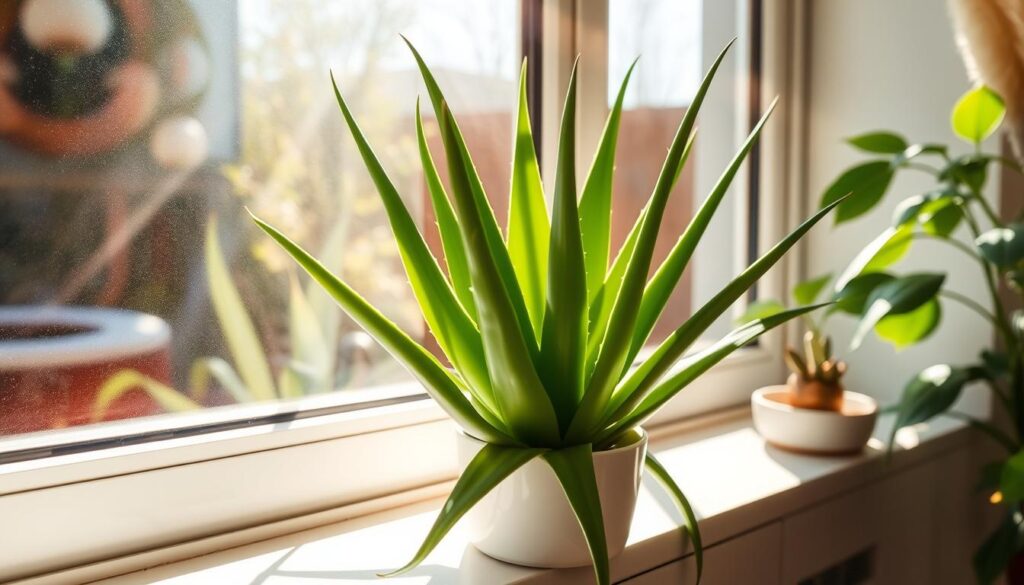
Choosing the right window for your aloe vera plant and moving it as needed is important. This way, it gets the sunlight for aloe vera plants it needs to stay healthy and vibrant.
Signs of Inadequate Sunlight Exposure
Aloe vera plants need the right amount of sunlight to grow well. If they don’t get enough, they can show signs of trouble. One big sign is leaf stretching and etiolation. This means the stems grow long as they try to reach more light, making them weak and easy to break.
Also, changes in leaf color can show if the aloe vera isn’t getting enough light. Yellow leaves often mean it’s not getting enough light for photosynthesis. On the other hand, too much direct sunlight can cause sunburn. This looks like reddish-brown to gray leaves, brown tips, and spots on the leaves. Leaves that droop or fall can also be a sign of sunburn.
It’s important to find the right balance of light for your aloe vera plant. Watching for these signs can help you fix any light problems. This ensures your aloe gets the light it needs to stay healthy.
“Proper lighting is essential for the growth and vitality of aloe vera plants. Paying close attention to the signs of inadequate sunlight exposure can help you provide the optimal conditions for your aloe to thrive.”
Protecting Aloe from Excessive Sun Exposure
Aloe vera plants can handle many light conditions but too much sun can harm them. To keep them safe, slowly get them used to more sunlight. Use light filters or shade during the hottest times to avoid sunburn.
Signs of sunburn include red or gray leaves, brown tips, and spots. If you see these, move your plant to a shadier spot. Finding the right sunlight balance is key for your aloe’s health.
Protecting Aloe from Sunburn
- Gradually acclimate aloe plants to brighter light conditions to prevent sunburn
- Use filtered light or partial shade during the hottest parts of the day
- Watch for signs of sunburn, including reddish-brown or gray leaves, brown tips, and irregular spots
- If sunburn occurs, move the plant to a less sunny location and allow it to recover
By managing sunlight, your aloe plants will thrive. It’s important to balance their sunlight tolerance and sun exposure for the best care.
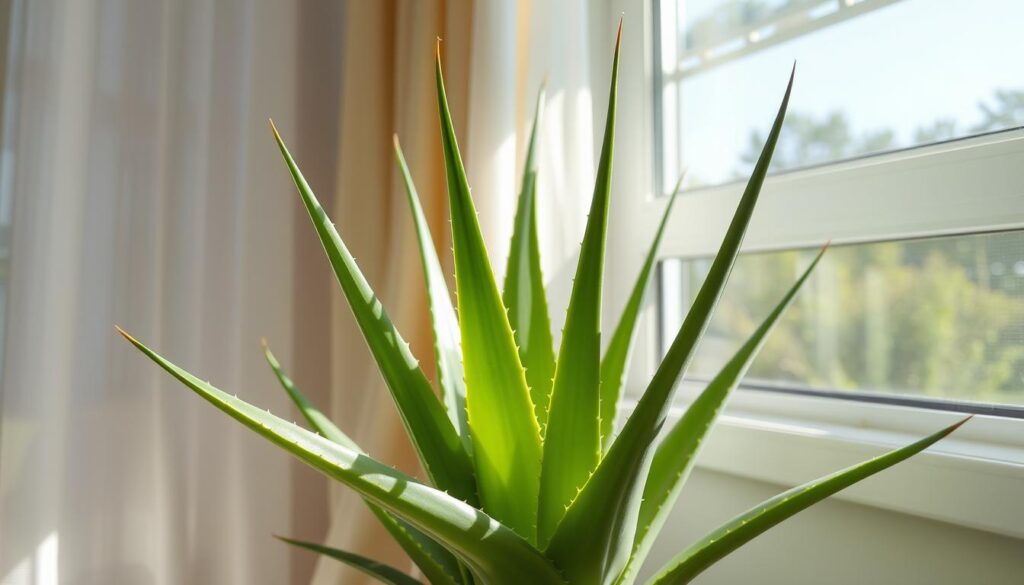
“Aloe vera plants are remarkably resilient, but they still require careful attention to their sunlight needs to prevent damage and ensure optimal growth.”
Seasonal Light Adjustments
Aloe vera plants need different amounts of light at different times of the year. Knowing how to adjust the light is key to keeping your aloe vera healthy and looking good.
Summer Light Requirements
In summer, aloe vera plants might need protection from strong sunlight. The aloe vera’s light exposure needs to be watched closely. Too much direct sun can burn the leaves.
Use sheer curtains or move the plant a bit away from windows during the hottest part of the day. This helps prevent the leaves from getting scorched.
Winter Light Adaptations
When the seasons change, so do the light needs of aloe vera plants. In winter, when the sun is weaker, aloe vera can handle more direct light. You might need to move your aloe vera closer to windows or a sunnier spot in your home.
By adjusting the light seasonally, you can help your aloe vera plant grow well all year. It will have healthy growth and bright leaves.
“Proper light management is essential for the well-being of aloe vera plants, as they have specific requirements that change with the seasons.”
Finding the right mix of direct and indirect light is crucial. It ensures your aloe vera gets the best aloe vera light exposure to thrive.
Indoor vs Outdoor Light Requirements
Aloe vera plants have different lighting needs indoors and outdoors. Aloe vera plants typically require full sun for at least six hours a day. They grow best with eight or more hours of bright light.
Indoor aloe vera plants do well near bright windows with indirect sunlight. Direct sunlight can cause leaf burning or discoloration. Outdoor aloe vera plants can handle more direct sunlight but still need shade during the hottest times.
When moving an indoor aloe vera plant outside, do it slowly over 7-10 days. This helps the plant adjust to more light without getting damaged. Start by placing the aloe in a shaded area and gradually increase its sun exposure.
| Lighting Conditions | Indoor Aloe Vera Plants | Outdoor Aloe Vera Plants |
|---|---|---|
| Sunlight Requirement | Bright, indirect light | Full sun (4-6 hours per day) |
| Acclimation Period | N/A | 7-10 days |
| Shade Needs | No direct sun | Some shade during hottest parts of the day |
Knowing the aloe lighting conditions and aloe vera sunlight requirements for indoors and outdoors helps your aloe vera plant thrive. It stays healthy, no matter where it’s grown.
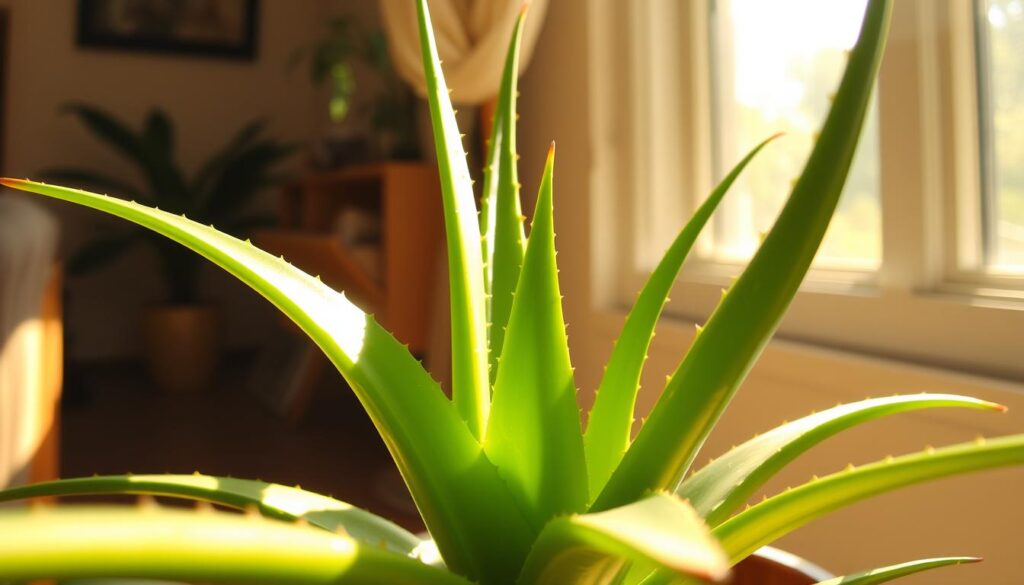
Using Artificial Light for Aloe Plants
Artificial lights can help when natural light is not enough for your aloe plants. White fluorescent lights 6 to 12 inches above the plant work well. For aloe light needs, artificial light should be on for 14 to 16 hours a day.
Types of Grow Lights
LED grow lights are great for indoor aloe plants. The S780 Series and S520 Golden Grow Lights are good choices. They offer even light and a spectrum that aloe vera needs.
Light Duration and Distance
Artificial lights need the right time and distance. The S1200 Series growing light should be 12-36 inches above the plant. A 13-18 hour light schedule helps aloe plants grow well.
“Aloe vera is a light-loving plant that grows best in places with scattered light.”
Fluorescent lights, like T5HO, give aloe plants enough light without too much heat. When aloe plants flower, change the light to help them grow naturally.
Keep an eye out for signs of light stress in your aloe plants. This ensures they get the proper sunlight for aloe and do well indoors.
Common Sunlight-Related Problems
Aloe vera plants are known for their ability to adapt to different light conditions. But, even these hardy succulents can face challenges from sunlight. One common issue is sunburn, which happens when aloe vera plants get too much direct sunlight. This causes brown or gray patches on the leaves, showing the plant’s struggle with the intense rays.
On the other hand, insufficient light can also cause problems. Without enough sunlight, aloe vera plants can become leggy and yellow. This is because they stretch to reach more light, losing their vibrant green color.
- Sudden changes in light exposure can also stress aloe vera plants, leading to leaf drop or color changes.
- Regularly monitoring your aloe vera for these signs and adjusting its position as needed is crucial for maintaining its health and appearance.
By understanding the aloe vera sun exposure and aloe sunlight tolerance requirements, you can ensure your aloe vera plant thrives. It will continue to provide its unique benefits.
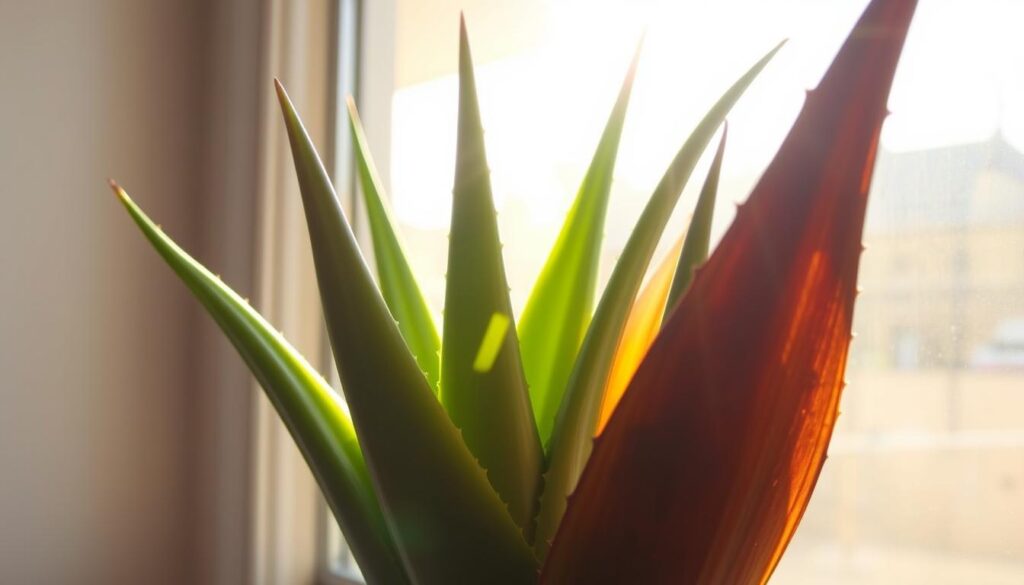
“Aloe vera is a versatile and low-maintenance plant, but it’s important to monitor its light exposure to ensure it stays healthy and vibrant.”
Optimal Temperature Conditions for Growth
Keeping the right temperature is key for aloe vera plants to grow well. They do best in daytime temperatures between 60 to 75°F (15 to 24°C). At night, they like it cooler, between 50 to 60°F (10 to 16°C). A big temperature change, at least 10 degrees Fahrenheit (6 degrees Celsius), is good for them.
Aloe vera plants can handle a lot of temperatures. They can go from as low as 50°F (10°C) to as high as 85°F (29°C). But, it’s important to watch out for different temperatures in your home. Places near windows can be cooler in winter or warmer in summer, affecting their growth.
| Temperature Conditions | Preferred Range | Tolerance Range |
|---|---|---|
| Daytime | 60°F to 75°F (15°C to 24°C) | 50°F to 85°F (10°C to 29°C) |
| Nighttime | 50°F to 60°F (10°C to 16°C) | 50°F to 85°F (10°C to 29°C) |
| Temperature Fluctuation | At least 10°F (6°C) | N/A |
By keeping the right temperature, you make sure your aloe vera plant environment is perfect for aloe vera care and growth.
Watering Requirements Based on Light Exposure
The amount of water an aloe vera plant needs depends on how much light it gets. Plants in bright spots need more water than those in dimmer places. Water the plant well when the top inch of soil feels dry.
Adjusting Water Schedule
In warm months or bright sunlight, the soil dries out quicker. You might need to water every 2-4 weeks. But in cooler months or low light, water less to avoid root rot.
Drainage Considerations
Good drainage is key for your aloe vera’s health, no matter the light. Use soil made for succulents and make sure your pot has holes. This stops water from building up and causing root rot. Adjusting your watering and ensuring good drainage helps your aloe vera grow well, no matter the light.
